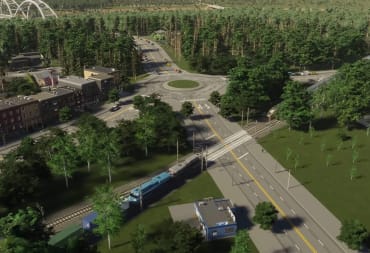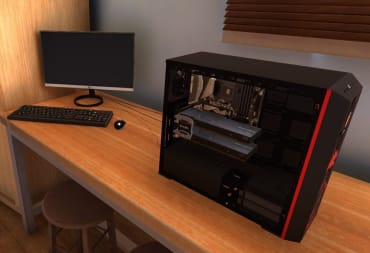PC Building Simulator is about as meta as it gets when it comes to simulator games. In it, you use your personal computer to virtually build a personal computer. I first checked out this game for Coverage Club before moving on to a preview during its time in Steam Early Access. Now that the game is out, I'm hopping back in to see what's new since the full release. I was also curious if the developers managed to edge things a little closer to realism.
If you're just here to tinker with parts, then PC Building Simulator has you covered with its free build mode. A tutorial is also available if you're a complete newbie; at the minimum, it will show you which components go where. The real meat of the game is in the career mode. A family member has left you in charge of his failing PC shop and you have the opportunity to turn things around. After completing a simple virus scan job, you'll move on to diagnosing broken PCs, upgrading them with new parts, and building bespoke machines for a variety of customers.
Once you know what you're doing, you can build a PC from scratch in less than five minutes. You'll actually spend more time researching the parts so you can meet the requirements while staying within the budget.
The gameplay loop for career mode is relatively simple. An order will come in and you can decide whether to accept or reject it. The order will ask you to diagnose, upgrade, or build a new PC. Occasionally, additional requirements like meeting a certain 3DMark score or using parts of a certain type or certain brand will be included. Lastly, most jobs will have hidden bonus objectives that you can complete simply by being thorough.
As a matter of practice, I would carefully research each job as it came in. Once I was sure I could complete it within the budget, I would order the parts with next-day shipping and end the day. I'd take care of the hardware end of things, and from there I would move on to cleaning for dust and running a virus scan. These would often solve problems that the customer didn't mention.
You can repeat this gameplay loop endlessly. You work towards buying better tools, upgrading your office, and purchasing shares of the business from your uncle. If you stay on the path, you'll eventually own it all. I played PC Building Simulator for 10 hours (on top of the 10 hours for previews) before calling it quits.

Unlike a first-person shooter or a dating sim, I actually have a lot of experience in what PC Building Simulator attempts to simulate. I've been doing freelance IT work for consumer and residential customers for well over a decade. Suffice it to say, I know my stuff. How accurate is this game?
For the most part, the actual building of a PC works much as it does in the real world. You don't have to deal with the various bits of packaging (which can sometimes be a pain in the ass). Nor do you have to deal with any shipping issues like delayed packages or damaged product. Once you do have the parts, the assembly portion is accurate.
As for the parts themselves, Claudiu Kiss and The Irregular Corporation have gone to great lengths to secure licensing deals with various hardware manufacturers. Not everyone has signed on board, though. As an example, there are no hard drives from Western Digital in the game (one of the oldest and arguably one of the most reliable hard drive manufacturers still on the market today). Several fictional hardware manufacturers (Shean, Mortoni, and DFL) exist to fill the gaps left by the missing companies.
Some entire categories of parts are missing. One of the more egregious examples is the total lack of optical drives. While most software has transitioned to purely digital downloads, there are still plenty of people (myself included) who like to have an optical drive available for short-term archiving and for installing old games that simply aren't available digitally. You also can't tinker with peripherals (monitors, keyboards, mice, printers, etc.), although this is planned to change in a post-launch update
The most egregious thing that PC Building Simulator gets wrong is data preservation. These days, the most valuable (and often irreplaceable) thing in a personal computer is not the graphics card or the CPU or any piece of hardware. It's the data. Customers will ask you to swap out hard drives with no mention of preserving any of the data on there; instead, a hard drive is treated as any other easily replaceable part. This is one of the most unrealistic parts of the experience. It's probably the area where PC Building Simulator most fails to capture the experience of this career.
One of the minor annoyances is the need to restart a PC every time you install one or more programs. The days of every program under the sun prompting you to restart your PC are well behind us. These days, you'll typically only see a program that needs to heavily integrate itself into the OS like an antivirus program or graphics driver necessitate a restart. It shouldn't be required for the music player or overclocking program.
There have been a number of changes from the Steam Early Access days. One of the worst ones is the way jobs work. Previously, you would immediately get a replacement job after rejecting one. Now, rejecting a job means that you won't get a new one until you begin the following day. If you happen to have a distaste for doing certain types of jobs (like, say, doing anything involving those pesky 3DMark scores), you'll lose a bit of productive time. I don't like this on a visceral level, but I suppose it makes sense from a balancing perspective. I can begrudgingly accept it.
The 3DMark jobs are as labyrinthine as ever. I had to do some research to discover that the CPU accounts for approximately 15% of the overall score and that it was heavily dependent on the graphics card. There's no in-game reference or anything like that save for the actual program documentation (which is a wee bit too technical for most people). I had to rely on a third-party guide. While this is a bit annoying, it's also very accurate to the experience of servicing a PC. You'll spend a good portion of your time looking up error codes and documentation as you try to diagnose and ultimately solve a problem.
Some kind of in-game web browser would have been nice to handle the times you need to research on the web. Yes, you can use the Steam overlay, but it would have been pretty cool to be able to use an in-game PC to get on the Internet. Heck, they managed to find a way to replicate your desktop background in-game automatically. I thought that was a really nice touch, and a functional web browser would have complimented this nicely.

Graphically, PC Building Simulator aims for a certain level of realism and handily manages to achieve it. The level of detail on the various PC parts is excellent; they've been lovingly recreated. The lighting effects aren't half bad, either! There isn't much in the way of sound effects needed for a game like this. The ones that are there are just serviceable. As for the music, the default tracks (which have expanded in number since Steam Early Access) are catchy and make for perfect video game music. Players also have the option to use their own music or Internet radio if they so desire.
PC Building Simulator gets the experience of working as a PC repair technician about 90% correct. Unfortunately, the 10% that's missing are some of the most common and important jobs, namely issues surrounding data preservation and recovery. You can certainly learn the basics by playing this game, but there's still a lot missing for a truly complete experience.
TechRaptor conducted our PC Building Simulator review on PC via Steam using a copy provided by the developers
Review Summary
Pros
- Mostly Accurate PC Building
- Wide Range of Licensed Parts
- Catchy Tunes
Cons
- No Data Preservation/Recovery
- Keeping Track of Parts is a Pain
- No Optical Drives
Have a tip, or want to point out something we missed? Leave a Comment or e-mail us at tips@techraptor.net












